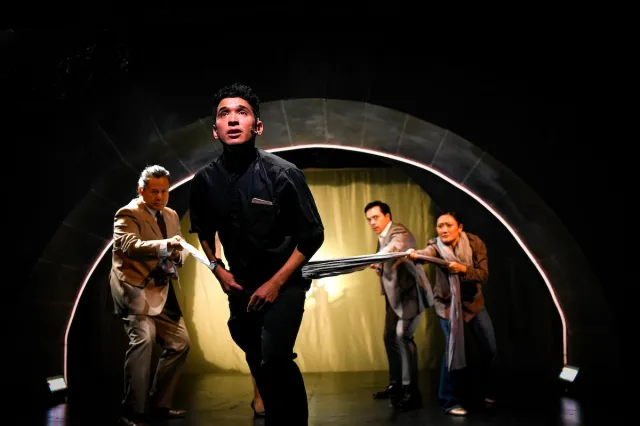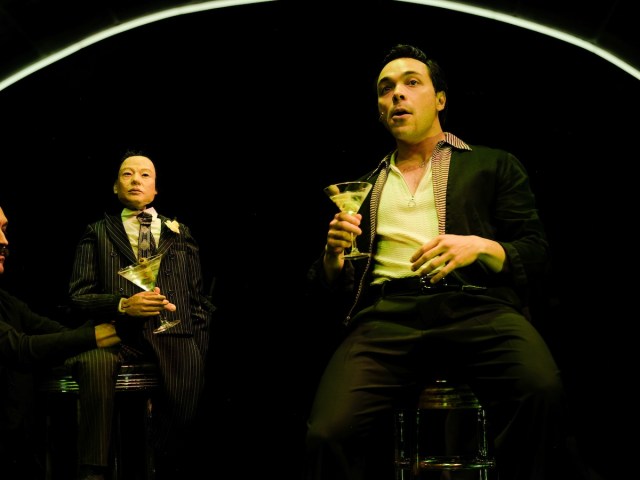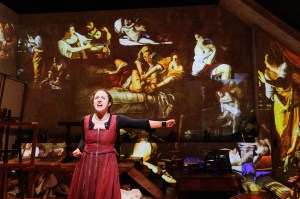Review: See What I Wanna See Returns Off-Broadway With an All-Asian Cast and Mixed Results
Out of the Box Theatrics has revived the Michael John LaChiusa musical at 154 Christopher Street.

(© Thomas Brunot)
One could consider Out of the Box Theatrics’ revival of Michael John LaChiusa’s See What I Wanna See an act of cultural reclamation. Given that it’s based on three short stories by Japanese writer Ryūnosuke Akutagawa, it seems logical that it ought to be performed by an all-Asian cast, which it most certainly wasn’t when it premiered at the Public Theater in 2005 with Idina Menzel, Marc Kudisch, and Mary Testa. In practice, though, despite a game ensemble and some intriguing, culturally distinctive touches in director Emilio Ramos’s production, the approach turns out to be a mixed success at best.
Some of that may come down to the musical itself. Akutagawa is best known to Westerners as the writer of two short stories that filmmaker Akira Kurosawa famously adapted into Rashomon, a classic film whose title itself is enough to evoke the idea of the unknowability of truth. For LaChiusa, however, both that film and one of the stories Kurosawa drew on, “In a Grove,” are mere starting points for a broader consideration of the highly personal nature of truth.
The first act is a 1951-set, noir-inflected adaptation of “In a Grove” revolving around the death of an unnamed husband (Kelvin Moon Loh), whose body is found by a janitor (Zachary Noah Piser) early one morning in Central Park. As in the story and the Kurosawa film, we see and hear differing accounts of the lead-up to the death from his wife (Marina Kondo), a swaggering thief (Sam Simahk) who instantly pines for her, and even the Husband himself as conjured up by a medium (Ann Sanders). Those who know the story and/or the film will hardly be surprised by the lack of clarity on which the act ends.

(© Thomas Brunot)
But the show shifts in the second act, where LaChiusa transposes the setting of Akutagawa’s “Dragon: The Old Potter’s Tale” to post-9/11 New York. Here, a priest (Piser) has a crisis of faith in the wake of that epochal tragedy that leads him to come up with a hoax: One day, he posts fliers around Central Park claiming that a miracle will occur three weeks later on a Tuesday afternoon. But the Priest doesn’t bank on the ruse attracting so many believers, including not only an unhappy actress (Kondo), a homeless former CPA (Loh), and a world-weary reporter (Simahk), but also his own aunt (Sanders), an atheist who, in the throes of terminal cancer, suddenly finds herself more willing to entertain the idea of God’s existence.
Both acts begin with prologues inspired by Akutagawa’s “Kesa and Morito,” in which the title characters (Kondo as Kesa, Simahk as Morito) claim they are about to kill each other, presenting their individual perspectives without resolving who killed whom. See What I Wanna See is essentially three short stories in one, bound together by theme instead of narrative. The second act is so much more engaging than the first act, and so tenuous is the thematic connection between the narratives, that one can’t help wondering if the show might have been better off without the earlier Rashomon evocations at all.

(© Thomas Brunot)
Ramos’s all-AAPI production occasionally makes a rather unwieldy show even more diffuse. The use of puppets to represent a couple of the characters may evoke traditional Japanese bunraku puppetry, but as seductive as it looks under Tom Lee’s puppetry design (and as operated by Nikki Calonge, Takemi Kitamuta, and Justin Otaki Perkins), it doesn’t silence doubts as to whether it adds anything to the storytelling.
More worrying are the occasional unaddressed dissonances between LaChiusa’s words and the actors reciting them: the wife in the first act declaring she doesn’t care about foreign films like Rashomon even though a Japanese actor is playing her; same with the priest’s aunt being directly referred to as Italian even though Sanders is very much not that. Such moments give off the sense of a production trying to force cultural specificity into material that, despite its Japanese source, doesn’t really support it.
Still, the show’s sense of an artist grappling with his own spiritual unrest is quietly moving, and LaChiusa’s score is as richly varied and expressive as his music usually is. Plus, the cast is by and large up to his demands, both vocally and in playing multiple parts. Piser is a standout in that regard, bringing a youthful freshness to the janitor and the priest but shading the latter role with poignant notes of anguish. If nothing else, this production brings back a musical that, as uneven and overreaching as it is, doesn’t deserve to sink into obscurity.












